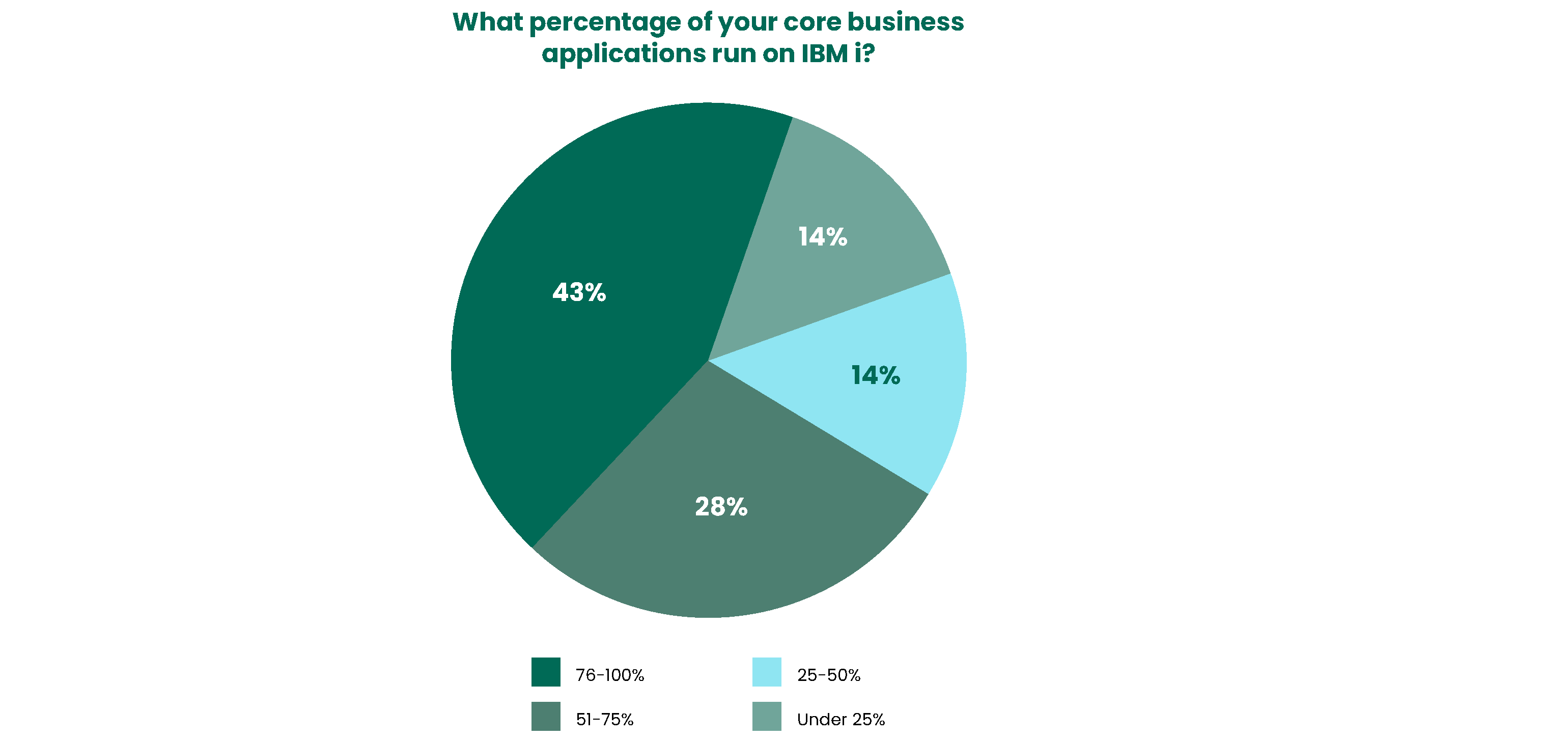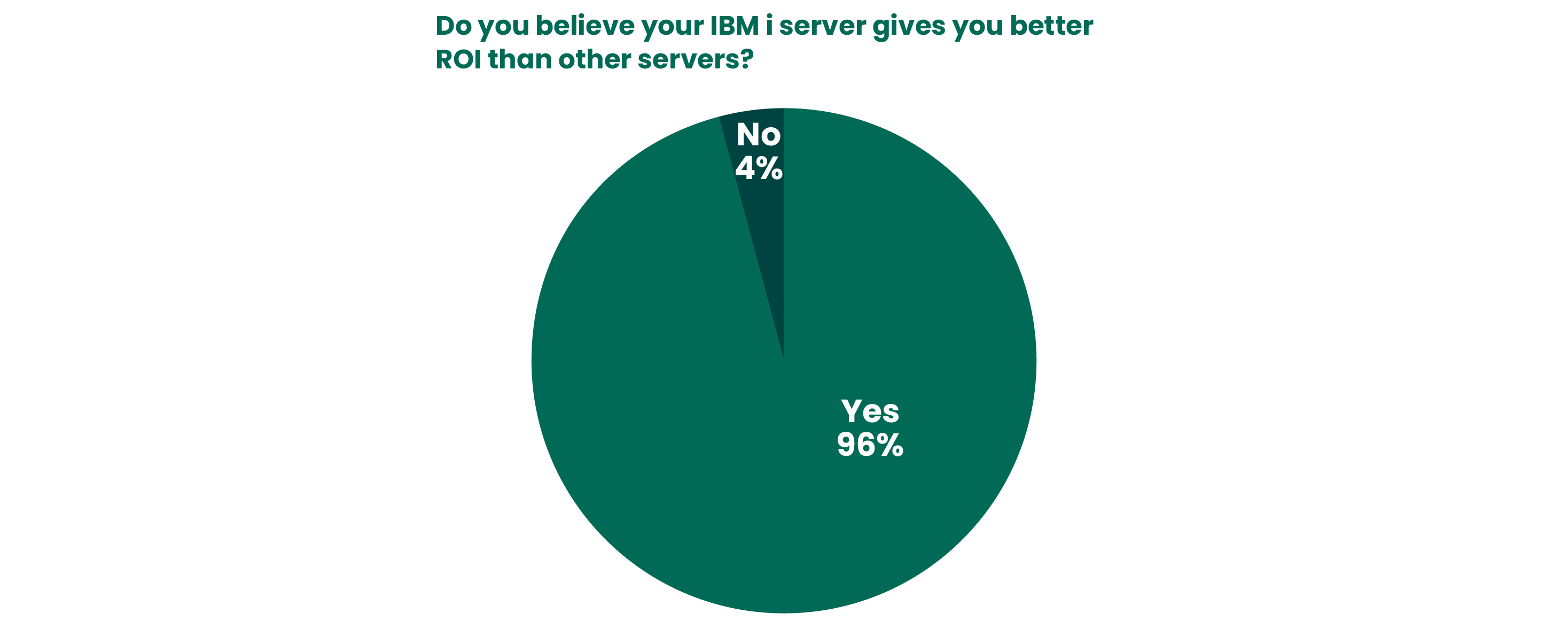1. Introduction & Survey Highlights
4. Outlook for IBM i (current page)
Business Applications
An organization can't function well without its fundamental business applications. These applications must be readily accessible, execute quickly, and provide enterprises with the assurance that they will perform as expected.
It’s no surprise that many businesses rely on IBM i for their most critical applications, given the platform's reputation for dependability and durability. Since 2016, respondents running between 51% and 100% of their core business applications on IBM i has remained stable at around 70%. This demonstrates users' confidence in the IBM i platform.
This year’s results mirror last year: 43% of survey respondents run more than 75% of their core business applications on IBM i.

RECOMMENDATION:
With applications relying very much on access to core business data, the role of business intelligence (BI) cannot be underestimated when it comes to successful applications. Fortra has a suite of BI solutions and services that dovetail seamlessly with IBM i and allow business users and leadership teams to make smarter and more informed decisions based on real-time data.
Plans for the Platform
We have seen the value that users get from IBM i throughout the 11 years that we have been conducting the IBM i Marketplace Survey. For proof, look to the percentage of people planning to increase their IBM i footprint. Just 12% planned to do so last year, but 20% intend to increase their use of this platform in 2025. A stable 56% of respondents either plan to make no changes to their IBM i or stay on IBM i but move to the cloud. From a management standpoint, IBM i requires fewer personnel and has a lower cost of ownership than other operating systems.
The percentage of businesses who will continue to use IBM i with no change in 2025 is greater than it was in 2024 (45% vs 43%). Additionally, the trend of customers moving to the cloud has slowed, with 10% of respondents reporting they will stay on IBM i but are moving to the cloud, compared to 13% in 2024.
18% of organizations are planning to move some or all of their applications to another operating system or service. Windows-based servers come out highest at 42%. If planning to move applications, Windows is not a surprising choice, as many organizations have Windows servers running alongside IBM i. The number of users planning to move applications to Linux remained steady at 38% and AIX increased to 11% (up from 8% last year).
There isn’t much of an exodus from IBM i, as roughly 3% of respondents plan to migrate all applications from IBM i within 2 years. Of those planning to migrate their applications from IBM i, 61% are planning to do so more than two years from now. In general, customers who don’t have a plan for moving within a two-year time span typically end up sticking with the platform. IT management often underestimates the time to switch and the long-term value of applications on IBM i.

RECOMMENDATION:
If you are thinking about leaving IBM i, you need to understand the true cost of migration. We have seen first-hand customers attempting to move off IBM i over a period of time and then failing to do so. This failure is very expensive to your organization as it sets you years behind in application modernization and hardware levels. Our recommendation is to talk to both consultants who are for moving off IBM i as well as those who are against the move. They will help you understand the true costs associated with replatforming.
Return on Investment
The most constant result of the annual IBM i Marketplace Survey over the past 11 years has been the value that IBM i provides to its consumers. IBM i has consistently delivered a high return on investment (ROI), and 2025 is no exception.
This year, 96% of respondents said they believe IBM i provided better ROI than other servers – marking a record high level of confidence in the platform’s business viability.
This number has never been below 90% in a decade of analysis, demonstrating that IBM is committed to maintaining a system that provides substantial value to its devoted clientele.
We know that many survey participants use multiple servers, so their opinions on the best server are well-informed. IBM i is a trusted platform, and its popularity will continue to rise in the years to come. The Global ITIC Reliability report from 2023 provides data on the reliability IBM Power servers, citing an astounding 99.9999999% uptime and reliability among z16 servers. This level of reliability coupled with financial feasibility delivers IBM i users a winning combination.
